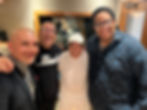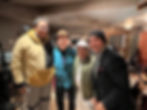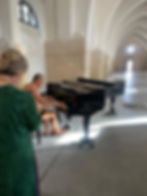Q&A with IRVING FLORES
- Jonathan Widran
- Sep 22, 2025
- 9 min read
Updated: Sep 23, 2025
Long renowned as a "Maestro of the Piano" and a master of melody and rhythm, Mexican-American pianist, composer, arranger and producer Irving Flores is equally celebrated for his explosive, truly surreal Latin jazz piano mastery and his award-winning orchestrations for numerous Latin legends, including Armando Manzanero, Luis Miguel, Eugenia Leon, Willie Colon and Tania Libertad.
Over the course of his illustrious four-decade career, he has worked with the 70-piece San Diego Symphony (including the ensemble’s recent “A Tribute to Frank Sinatra”) and shared stages with jazz greats Poncho Sanchez, Airto Moreira, Alex Acuña and Justo Almario. In addition to Sanchez, Moreira and Acuña, he has collaborated with many others, including Bill Watrous, Akira Jimbo, Charles McPherson and the Spanish Harlem Orchestra.

Through his Jazz Education Network, he has been a mentor to many prominent Latin artists, imparting his knowledge through piano instruction, composition and arranging with an emphasis on Afro-Cuban and Latin rhythms. Now residing in San Diego, California, Irving curated the “Between the Notes” jazz series at Senses Bistro, UC San Diego Park & Market, continuing to innovate and inspire as a pillar of the jazz community. The series will now move to The Bella in La Jolla.
Flores calls his latest album Armando Mi Conga “a love letter to Latin America. It’s my journey and a tribute to the rhythms that shaped me.” The album features some legendary figures in jazz, including Giovanni Hidalgo (congas), Brian Lynch (trumpet), Horacio “El Negro” Hernández (drums), John Benitez (upright and electric bass), and Norbert Stachel on tenor sax, baritone sax, clarinet, and flute, showcasing Flores’s ability to bring together top talent to create truly spectacular music.
Your last album American Influence was released in 2013. Why did it take 12 years for you to release this extraordinary follow-up?
FLORES: Honestly, it’s not easy to have the financial support to record albums of this magnitude. Unlike many musicians who make much of their living teaching at universities and have established themselves financially that way, I’m 100 percent a working musician. As far as the ability to gather a lot of musicians in one place to record, it’s a different industry compared to when Quincy Jones recorded his all-star albums. On my earlier recordings I had the support of people who trusted me and was able to work with some greats like Justo and Alex, and it took a while to gather that kind of support this time, and also to arrange everything with the musicians I got to participate.
When I married my wife Amanda, I married the #1 fan of my music. She asked me what I wanted to do, and when I told her about my concept for Armando Mi Conga, she asked, okay, how do we make it successful? I said I need to record it in New York, and she asked who I wanted on the album. Having well-known musicians was key because radio stations are more inclined to play music featuring artists who are known quantities. Amanda really motivated me to put the pieces together to make it happen. I’m going to start recording another album in January to keep the momentum going.
What inspired you to create Armando Mi Conga and why was now the perfect time to write and record it? What was the spark that inspired the project and what was your original vision?
FLORES: I composed the title song in 1994, and it had an immediate strong impact on jazz society in my native Mexico. I remember I played a concert with trumpeter Gilbert Castellanos and NY drummer Willie Jones III. Willie loved my composition since I described it to him as a "simple AABA that we made jazzier and more rhythmic." In 2020, Brad Steinwehe requested that I orchestrate the tune for his big band project. But it was as if I had this powerful product in my trunk or closet and nothing happened until Amanda inspired me to do something bigger with it. She was a dancer and has the rhythm inside her. She envisioned it as the title track to the project I had been longing to make.
I decided to put all the energy around that tune and others that would reflect different sensations, different kinds of Latin jazz rhythms and different formats like a trio or quintet. We went down to Puerto Vallarta to celebrate Thanksgiving with Amanda’s parents in November 2023. She put a piece of paper in front of me, asking how can we make this composition successful? By March 2024 we were in the studio with these great musicians recording the album!

You said, “This is a love letter to Latin America. It’s my journey and a tribute to the rhythms that shaped me.” Was this the concept from the start or did it take shape as you were writing and recording these great songs?
FLORES: I compose a lot of pieces, and we literally had over 100 compositions to choose from, so this album was very curated. I based many of my choices on the “colors” that would work best with the ensemble I gathered. “Armando Mi Conga” was of course the main thing but after that it was between my past and current life as a musician and artist. When I wrote “Samba Con Sabor,” I visualized Horacio Hernandez playing it and suddenly he was! I knew Brian Lynch would be the perfect trumpeter for “Armando…” To make it like a journey through Latin styles, I knew it would be best, in between all the high energy, rhythmically powerful pieces that took the music to another level, to have peaceful tunes for balance. In the future, I will do the same on my albums – draw compositions from my past and present to create a perfect blend representative of all the music I love!
How did you put together the great sextet for this album? What were your criteria and why were these the perfect guys to help you execute your vision?
FLORES: Every single musician on this album represents some aspect of my life and I have big respect for all of them. I respect their dedication and their love for the music because it was a mirror of my own passions that kept me focused and inspired me to bring the same intensity to the playing, arrangement and production. I have been following conguero Giovanni Hidalgo all my life and I’m impressed with how he blended the rhythms and measures. Early in my career, I became aware of and started to likewise follow bassist John Benitez. To have a player like him makes it easier to create those powerful rhythms.

I originally met Brian Lynch at an Eddie Palmieri concert, and he blew my mind with his incredible balance and finesse between straight ahead and Latin jazz. And I met Horacio Hernandez in Monterrey, Mexico 25 years ago at a music clinic. The organizers of the event were at a jazz club and asked him to jump on stage and play but he said he was there to relax and enjoy the music. They asked me what I did. I told them I play the piano and they let me play a solo of an original tune I had called “Recuerdos,” which is now on this album. Horacio actually jumped up onstage and started playing it with me. It's one of my favorite stories behind this album. I’m glad Horacio got to see me play that night and we have the same respect for each other now.
As you mentioned, an earlier version of “Armando Mi Conga” is on the Sonic Colossus Jazz Orchestra’s On a Clear Day (2020)? From your perspective, how is this version different and what makes it a great centerpiece and title track for the new album?
FLORES: It’s different because when I started thinking who is going to play the music on this album, to make it successful compositionally and arrangement-wise, it had to match the styles, artistry and colors those musicians would bring. Just like the big band version is amazing in its own way because it’s played in a straight-ahead jazz way by experts on straight ahead jazz who were all American musicians. As for how it was recorded, it was different. For On a Clear Day, the big band was recorded in sections, with the rhythm, sax, trumpet and trombone sections created separately. For this album, the adrenaline was insane, and they knocked it out in one take.

What were the sessions at East Side Sound in NYC like?
FLORES: Amanda was surprised that I never wrote a chart for “Recuerdos” in the 30 years since I wrote it. I think it was because while I was playing it for many years, I was always trying to perfect it, and I always wanted to record it with John Benitez, so it made sense to wait till I had him before I wrote that part. I was prepared for a lot of the session while other aspects were left to a little more improvisation and chance. I took advantage of having Brian Lynch and Norbert Stachtel and upgraded and adapted the tunes to include more of their playing. I’m grateful the budget allowed me this leeway. I worked to put the puzzle together rather than just following the charts I brought to the letter. We arrived at the session without rehearsal.
We had a few problems, though. First, Horacio was stuck in Miami after a flight from Cuba so he thought he might be late. When he arrived, he couldn’t open his luggage, so he was unable to access his cymbals and bells. Then the bass fell and broke, but we got that fixed. I was practicing on the piano at the studio the day before and the guy at the studio told me it was going to be tuned and ready for the session. The next day when I started playing, I realized it was out of tune. Norbert tried to fix it but we ultimately had to call a new tuner in NYC who came and fixed it. Finally, everyone had the charts I came with, and I described the compositions to them.
When we started playing it was like turning on a car engine. The first tune we recorded, “Gary En Nanchital” was a medium tempo number that set the tone for the whole session. I’m grateful that we got 80 percent of the tunes on the first take. I remember everyone was waiting for me to play my first piano solo and when they listened to it in the booth and it sounded good, it was like a carnival. Everyone was excited and jumpy, and we knew things would go great from there!
It feels like “With Amanda in Favignana” is the most personal composition. Tell me about its inspiration, and how its energy reflects the love you have for her? Why is Favignana a special place?
FLORES: Amanda and I went to Italy when her son, my stepson Leo went to attend a camp in Switzerland for two weeks. We spent some time in Switzerland, then she took me to Sicily and the city of Trapani. You have to take a ferry to cross to Favignana, the largest of the Egadi Islands. On this tiny island, we had an incredible time biking and eating the amazing food. Amanda asked everyone she met if there was an acoustic piano anywhere nearby and nobody had one. Then she found an old friend she had met there the previous year, a boutique owner, who took us to a monastery which had once been a place where fishermen beat and canned tuna. It looked like a cathedral. In front of the building there was a Yamaha C7 piano, sparkling brand new and still in the packaging Sansone. I played the piano for more than an hour there!
The next morning. I woke up at 4 am with the introduction of a song in my head, which I received as a message in a dream. The next day, with the nearby island of Marettimo in front of me, I started writing “With Amanda in Favignana.” When we returned to Switzerland to pick up Leo from camp, there was an acoustic piano there and I started reviewing what I had composed. When I wrote it I heard it one way in the moment, but when I listened again, I knew it was going to be a beautiful tune. I had the idea to play a full ensemble version and then a different version as a piano solo at the end of the album. The rhythmic Latin jazz vibe is a way to describe her personality and dance background, and the gentler solo piano is a quieter reflection. I felt like the world needed to hear both versions.
Listening back, what do you like most about Armando Mi Conga and what do you hope listeners get out of the experience of listening? What are you looking forward to most about playing these pieces live for people next month?
FLORES: I’m always looking to share my compositions with people and put something beautiful and exciting into the universe, hoping to inspire. To pinpoint one single thing I like most is difficult because every single second and moment is important to me in my heart and reflects the heart of the way all the musicians put their hearts into the production. I think the music will speak for itself. When I create music, it’s always about getting those special reactions, like people shedding tears or happily screaming. When I compose a song or record an album, I just want to create happiness that goes into the hearts and souls of people.







